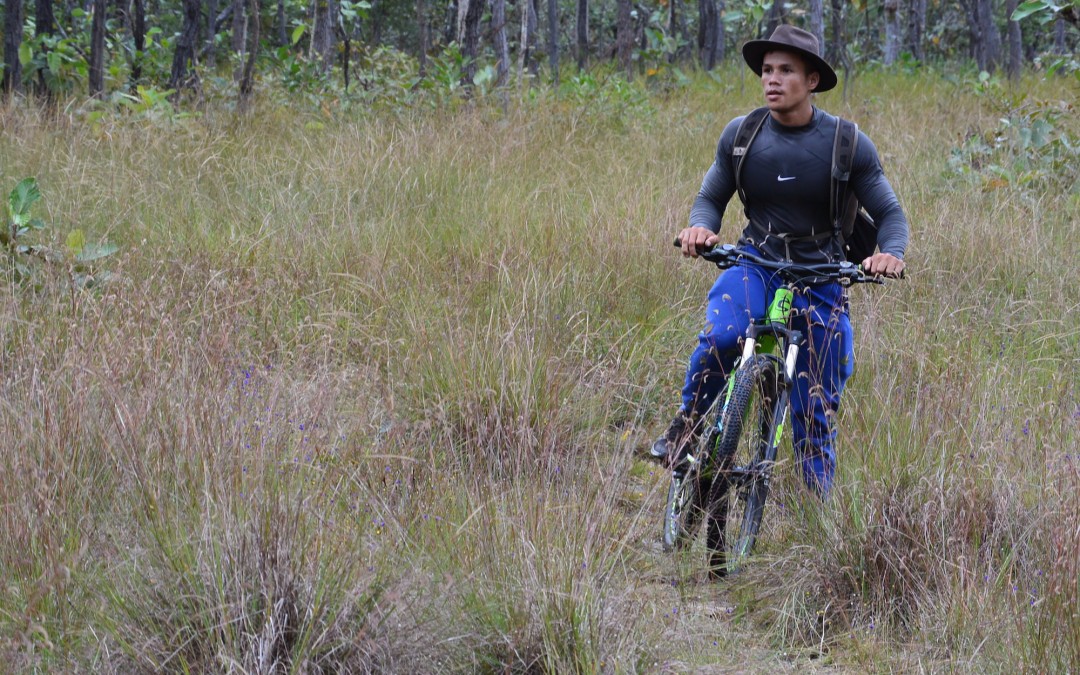
by Nick | Mar 19, 2020 | Bike, Blog
A Race to the Middle of Nowhere – The Scramble for Kulen with apologies to Thomas Packenham (The Scramble for Africa*)
We were about a thousand years too late but then it wasn’t for the first time, the Angkorians had been here before. And anyway the British, French, Germans and Italians took it in turns to claim large chunks of Africa*. I reckoned all we needed to do was plant an Indochine Exploration flag on the top of Phnom Srok, Mr Leang said was the tallest hill on Kulen, to guarantee safe rights of passage across Kulen for our Grasshopper guests the following week.
Lors had filled Kuong’s van with enough equipment to rival our pioneering colonial peers on a country conquering expedition. The ‘stuff’ wasn’t the half of what he’d be taking for the guests. We were just using hammocks to swing ourselves to sleep under the stars, though I wasn’t leaving it to chance and had my camping kit of Valium, whisky and ear plugs within easy reach.
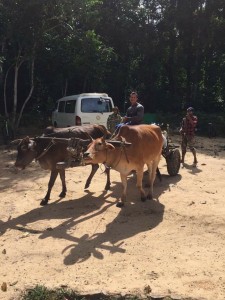 Loading Mr Chou’s oxcart
Loading Mr Chou’s oxcart
The escarpment up Kulen marks a departure from the dusty plains and chaos of Siem Reap. The forest canopy encloses a calm that penetrated even Kuong’s van. The MoE Station at Preah Ang Thom is where we start our trips and where we emptied the contents of the van onto Mr Chou’s Oxcart, while Phum – our guide for the next 24 hours, rode around the station getting used to the mountain bike we’d brought him.
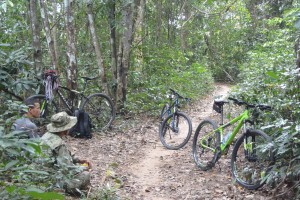 Our lunch spot
Our lunch spot
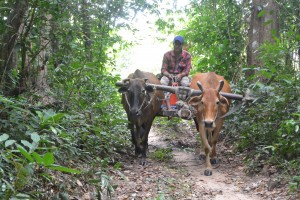 The guests arriving
The guests arriving
Lors fresh from his muscle contest in Phnom Penh and rippling in lycra, conducted our expedition as we embarked on our mission to cross the empty quarter by way of Porpel Village to Kbal Spean.
We followed a path between chamkar clearings that had been hacked and burnt out of the forest for the cashew nut plantations which, deplete the painstakingly accumulated fertility in a couple of years then wither to a scraggy halt.
We halted where the path went back under the trees and waited for Chou and his cows. Lors had bought a chicken for them. I’d got a squashed breakfast bagel from Little Red Fox. The chamkar finished at an escarpment and so apparently did our way. It was used to get timber out from the forest below but Phum told us that the illegal logging had stopped, incredible! He seemed to be right. It appeared that nobody had been this way for years. There was a path but it was so well disguised that when it changed direction I didn’t and came to an impromptu halt in the bushes*
 Relaxing* on the trail
Relaxing* on the trail
Chest high grass on the steep slopes gave way to forest as we reached the valley floor. Two years ago the saddest logging was taking out the remaining big trees. Now the vegetation was striking back, linking limbs to lock in the road and block the oxcarts that had born the bloodied corpses of felled trees.
We emerged out of the jungle into a flower-studded meadow bisected by the Kulen River. Our campsite was given away by rusty pilchard tins now hidden by the tall grass, evidence of Alistair’s (my previous business partner) search for Silver Langur Monkeys.
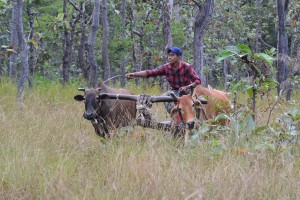 Arriving at the campsite
Arriving at the campsite
It seemed impossible that Phum and Chou would get the oxcart down the escarpment with no apparent path and then through the jungle so we headed back, fully expecting to abort our mission and spend the night in Anlong Thom. We found them a short way back hacking at a fallen tree, while the cows contentedly munched the leaves blocking their path.
 Lors and ….
Lors and ….
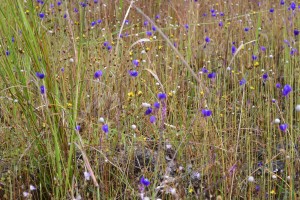 other flowers of the veld
other flowers of the veld
Our mission to cross Kulen was back within our grasp. Chou had a kettle on the boil while Lors and Phum set up the campsite and I drank tea.
 Lors and Phum preparing supper
Lors and Phum preparing supper
‘Nick get out of the way,’ warned Lors. Phum was flapping his hammock and stamping on the ground to get rid of black ants. ‘I cant get out of the way! Aaargh’ the little bastards stung, but they weren’t immune to deet.
Only a trickle of water made it down the stream despite the recent rain but the bathing pool remained. I reduced its surface tension by soaping up in the slightly cool water then went back to the campsite to drink beer and watch Lors shirtless cook dinner.
One week on from coming second in The Angkor Body-building Championships, it looked as if he could glide like a flying squirrel with his enormous deltoid muscles. Wielding a large bladed kitchen knife he alternated between slicing onions and swatting mosquitoes on Phum, for some reason remaining immune to their bites.
We were missing Dean but in his stead he’d sent a family sized pack of chicken casserole supposedly just for Lors and I, actually enough to feed all of us for dinner and breakfast. Beer then whisky as Lors and I contentedly chatted about nothing in particular. Mr Chou was wrapped in his hammock betrayed only by his gleaming white smile, 22 and with a baby on the way.
A full moon appeared through the canopy and shined silver on the bark of the trees that seemed to grow taller in the dark.

I lay in my hammock looking up through the branches at the stars, thinking that a simple camp in the forest was worth a million times more than whatever the 5 star Sachaya Resort on Bintan Island had cost where I’d been the week before.
The lingering chill from the night lifted as the sun lit up the leaves around us. Mr Chou and the ox-cart returned to rendezvous with Kuong, while we struck through the wilderness to find a route via the North Escarpment to Kbal Spean, not quite ready for how wild it turned out to be.
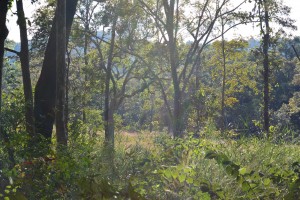
Elephant vomit or pig-shit grass life a soft fur covered our way but unlike soft fur it sticks its scratchy seeds to your socks and gets in your shoes. Enchanted glades of dipteropcarp deciduous trees gave way to dark caverns shaded by green and lit with white flowers on the forest floor.
The rocks and ruts were throwing me at every turn sapping confidence such that I pushed the bike as much as rode it.
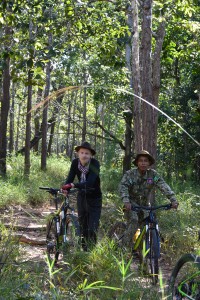 with Phum on the trail (left)
with Phum on the trail (left)
We met Leang the policeman with Chomran from Porpel village and two rangers with guns though it seemed unlikely they worked. A few months ago they’d arrested two loggers who were in jail and fined five others $1250 each. They were confiscating their chainsaws and fining the owners, which explained why the logging trail was disappearing. Leang had even seen the scratch marks of a bear at Kbal Spean and they reckoned they were still there in the Porpel Community Forest. An old bear had been hunted and killed for its bile. The hunter got $1000 and the middleman $6000 all for some fat ugly bong thom and his libido.
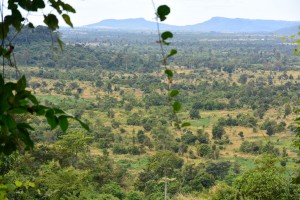 The North Facing Kulen Escarpment
The North Facing Kulen Escarpment
The North-facing escarpment had been logging central 2 years ago. Oxen and carts congregated with crude cut planks from freshly felled timber, which was stashed at the base of the cliffs and hidden so it couldn’t be spotted from the Wildlife Alliance helicopter that was surveying the mountain. Piled ready to be collected and taken out via the Forestry Administration HQ who extracted their toll and waited for the next batch to extort. Today there were no signs of logging.
Dr Livingstone I presume? Said Stanley, rather more usefully ‘would you like a beer?’ I was asked as we arrived at Kbal Spean. It had only taken 5 hours but as Dave Taylor had said the last time we attempted the route, while lying flat on the grass, ‘this is challenging,’ and technically not a mountain bike ride.
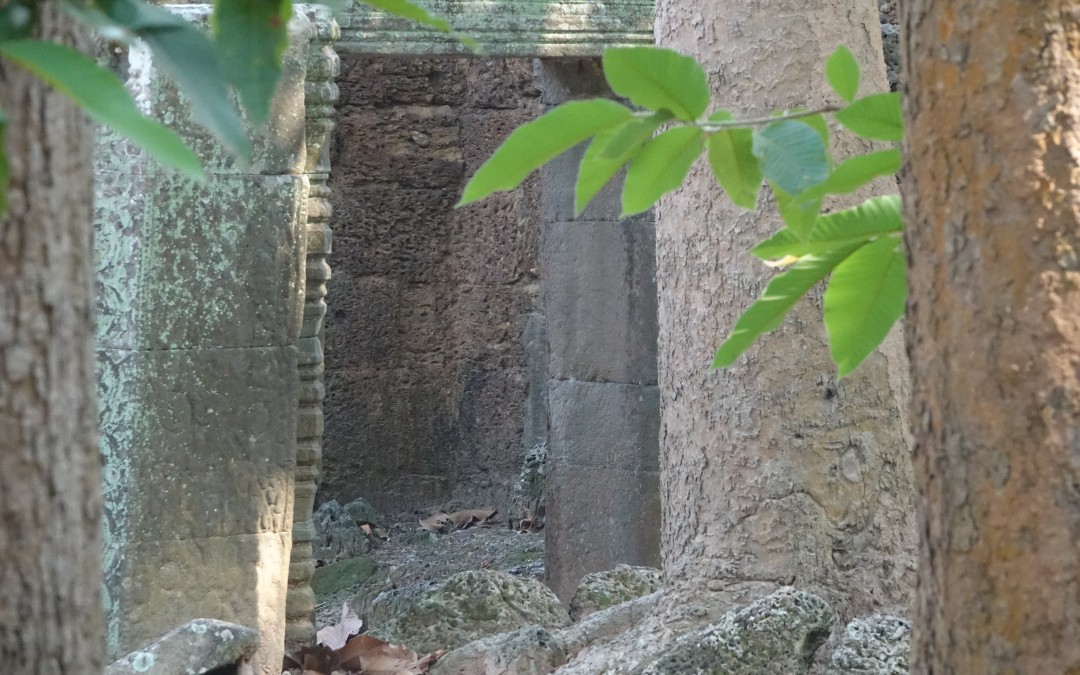
by Nick | Jan 29, 2020 | Angkor, Uncategorized
The Dry Season Temple Hunting Jeep Safari
We travel in reverse chronological order starting with 2 temples from the Bayon period.
The Buddhist king Jayavarman VII (or JVII for short) crammed into his thirty year rule the largest building program ever undertaken during the Angkorian era. At the center of his empire was the city of Angkor Thom and his state temple the Bayon.
Not far from the North Gate of Angkor Thom, off a red earth road and down a sandy track is Prasat Chan Ta Oun, once upon a time a Buddhist monastery.
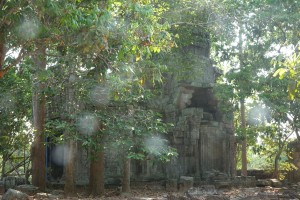 The central tower of Chan Ta Oun
The central tower of Chan Ta Oun
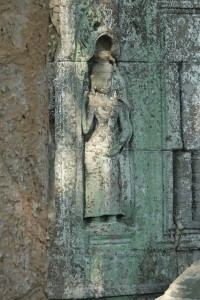 A divine figure from Buddhist mythology
A divine figure from Buddhist mythology
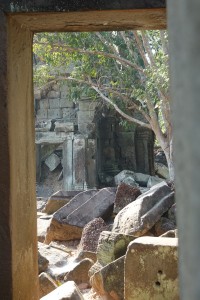 looking into the inner enclosure of Banteay Thom
looking into the inner enclosure of Banteay Thom
Banteay Thom also close to Angkor Thom* is built on a larger scale and harder to find, which is part of it’s charm.
*Thom being the Khmer word for big and Prasat means temple
There are two laterite walls with a moat in between and an entrance from the East. The inner enclosure is surrounded by galleries that can still be entered but not recommended for arachnophobes.
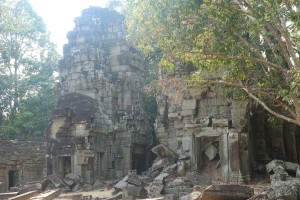 The central towers of Banteay Thom
The central towers of Banteay Thom
The three central towers that have been dug out for treasure are looked on by carvings of Buddha in his Bodhisvatta state of enlightenment.
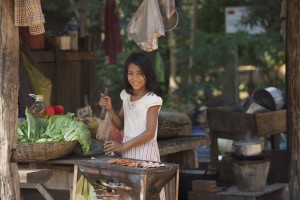 Phum Char (or Char Village)
Phum Char (or Char Village)
Small roads through stilted villages in countryside not much changed since the temples we visit were built. We’ll stop on our way to have a wander through and learn a little about what life is life in rural Cambodia.
We head back in time 200 years and along a red earth road to find Prasat Char (lit. temple of the palm tree) commissioned by Jayavarman V. There are clues as to its construction from the Sanskrit engravings in the stone doorframe.
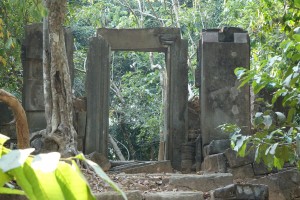 Prasat Char
Prasat Char
An uncertain fate is said to befall the translator as a five-headed dragon awaits those who understand the meaning of these runes.

Another 200 years back in time and we’re swapping the Angkorians for the preceding Chenla period when the Hindu brick temple of Prasat Kok Po was first built. ‘The Island Temple’ appears just that, set on a rise and surrounded by a rainy season moat.
 Prasat Kok Po
Prasat Kok Po
Restored by JIII in the 9th century as detailed in further Sanskrit engravings but this time with no dragons involved.
Spean Memay or Bridge of the mirror now crosses a dry field but once it lead from the North West corner of the close by West Baray, and headed to the Western borders of the Empire in Thailand.
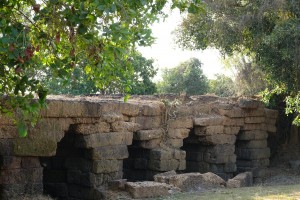 Spean Memay
Spean Memay
The bridge 79 meters in length and made up of 29 arches built in the 12th century survived Typhoon Ketsana, which washed away many modern bridges in 2009.
From Spean Memay we drive up onto the banks of The 11th century West Baray, which at 8km long and 2km wide was until the industrial revolution the world’s largest entirely man made reservoir.
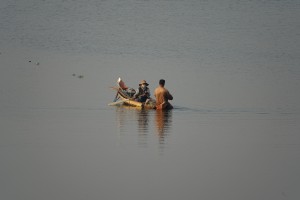 The West Baray
The West Baray
A permanent body of water that is still used to irrigate the rice fields to the South and Siem Reap’s beach resort. The traditional Sunday pass time for the family is to lie on a bamboo platform overlooking the water, drinking beer and gnawing BBQ’d chicken.
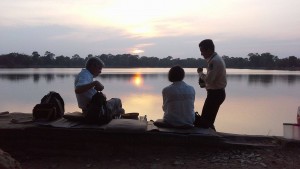
We’ll finish our temple hunting with a picnic lunch or a cold beer looking out across the water to the forests of Angkor behind.
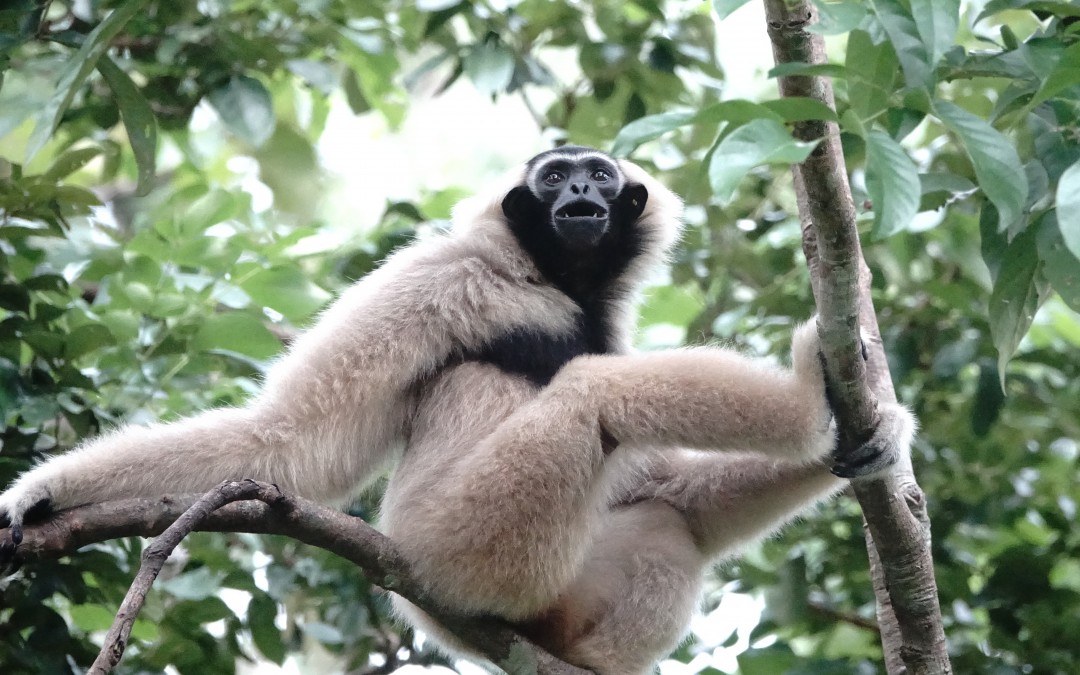
by Nick | Oct 11, 2019 | Bike, Blog, Conservation
A BeTreed Blog or The Adventures of BeTreed
BeTreed by myself in January 2017 (A BeTreed Adventure; https://indochineex.com/blog/a-betreed-adventure),
Then the Phnom Tnaut hike with Buntha and the boys. Hiking in the hills along snake trails and dodging trees while hanging from a zip-line.
And now retracing the forest paths to Preah Khan that we’d cycled with Laura and Ra.
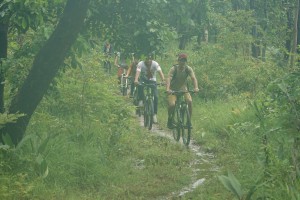 Manus leading the group on the forest path to Preah Khan
Manus leading the group on the forest path to Preah Khan
This time with Manus, my partner. I want to see the forest, he said. Buntha and Sreymom, my colleagues and friends – also wanted to come, then Veasna Buntha’s wife and Pov, the van driver, what was he going to do while we were playing in the forest? And finally Mengly the chef, we had to eat so he was welcome.
BeTreed is a lodge that Ben and Sharyn built from fallen timber, where guests can stay (including the fabulous tree-house) to experience the 6000Ha of community forest that Ben is protecting with a few rangers. It’s in the middle of a fast contracting no-where that’s difficult to get to in the dry season and now the rain is here it’s nigh impossible, as we found out.
There’s not much time, said Ben. The waters coming, he added. It all seemed to be going so well. NR6 was clear and Stoung within easy reach of Siem Reap. The new red earth road North had actually been paved most of the way. No rain, no wrong turn through three provinces all the way to the Preah Khan Baray, though we shouldn’t have been at Preah Khan or its Baray.
It was at this point the rain did come. A gentle drizzle at first but before long the clouds were spewing great blobs. We rang Ben but that didn’t help much. I can’t understand what he says face to face but over the phone impossible. Go back to the main road, which main road? The one you were on. That didn’t help. I tried a different tack, which village should we head for? Ben speaks better Khmer that English so I gave the phone to Buntha and we seemed to be on the right road for Ta Bos Village. That’s what I asked!
Ben was waiting in the village with his new pickup truck from the Ministry. We’ve got to go. We threw five of our bikes plus enough food to last a month, which was probably how long we’d be there if it didn’t stop raining, into the back of the truck and set off along the dirt track. Pov was locking up his van and had to run, jump and was caught by Manus and Mengly.
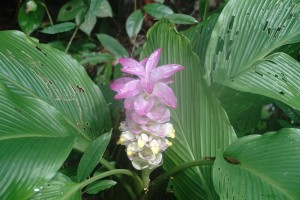 A forest flower
A forest flower
Buntha and I cycled crazy into the rain fuzzed night after the diminishing tail lights scared we’d loose the way.
We thought the car had sunk under the first torrent we crossed just in time to see it emerging on the other side. Energized we followed along the forest track to BeTreed. Drainage ditch planked crossings, rocks and fallen logs we couldn’t see. The trees blanked out what little light there was. Spasmodic bursts of lightening lit up the dark. Where the road turned we carried on into the bush then made a wrong turn. What to do lost in the forest in torrential rain?
Eventually after retracing our route the welcome chaos of BeTreed beckoned and we climbed the steps.
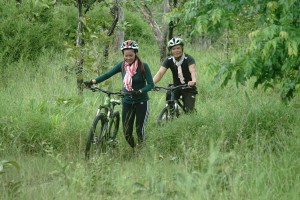 Veasna and Buntha
Veasna and Buntha
Buntha and I made puddles, Pov hovered while Mengly directed Sremom, Veasna and Manus as they sliced and chopped their way through the ingredients of dinner, which was spread out across the table as a vast array of food. I made introductions to Ben, Buntha and Sreymom who work with me, etc. and Manus. The relentless rain just kept pouring. Only 5% chance of precipitation today according to the forecast but more like a hurricane’s hit us, said Ben.
That didn’t help as we made our way up the hill to the tree house along what was now a river. At ten meters high there was a fair chance that the water wouldn’t reach our platform but it was doing its best to get through the roof, which sounded like a kettledrum from exploding water drops and thrashing branches.
We must have slept when the rain stopped and woke to a sodden forest so saturated that many of the branches were broken.
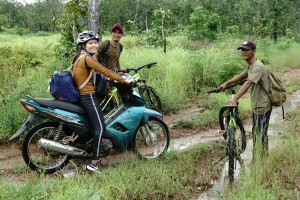 Sreymom, Manus and Try our guide
Sreymom, Manus and Try our guide
The forest was lush, it almost wobbled as we cycled. Mud filled ruts caught our wheels and prevented pushing the pedals. A dripping landscape of infinite biodiversity, Manus and Mengly who were leading the way saw a family of pigs. Sreymom fainted and traded her bicycle for Try, our guide’s motorbike. He followed ready to push her out when she got stuck. Veasna harrumphed and Buntha waited for her.
We left the forest into an illegal chamkar or cashew nut clearing. After Ben and his team cut down the saplings the farmer sprayed it with a sabotage of Roundup in 2017. Despite this it was already sprouting the green precursor to a forest.
Manus the self declared best biker was near the front at least until he got indigestion from eating too much, which coupled with exhaustion from the day meant he was going to die that night.
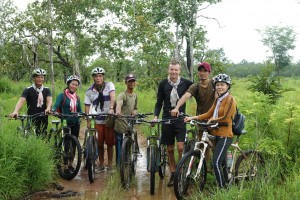 Left to right; Buntha, Veasna, Pov, Try, Nick, Manus and Sreymom
Left to right; Buntha, Veasna, Pov, Try, Nick, Manus and Sreymom
The hard exercise scarcely dented Try our guide. Also Mengly our chef appeared unfazed. I was tired and aching but kept going.
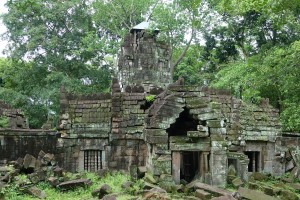 Prasat Preah Steung, part of the Preah Khan complex of temples
Prasat Preah Steung, part of the Preah Khan complex of temples
Finally we reached Ta Siem, the gastronomic capitol of Preah Vihear and had a nice omelet and cold beer in the local restaurant, while a child watched War of the Worlds set against a muddy market.
 Manus soaked in sweat after the ride
Manus soaked in sweat after the ride
We cheated and sent Pov ahead to fetch his van so we could look out over the soaked countryside from the comfort of the aircon vehicle in contrast to a mud clogged mountain bike.
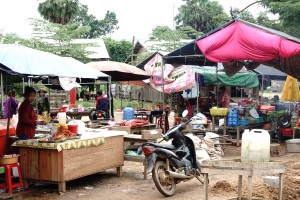 Ta Siem Village where we had lunch
Ta Siem Village where we had lunch
We regrouped at Ta Bos Village only to be met by a lake on the other side where the day before there had been a river. There was a bridge that Ben had built with most of Ta Bos village but not the owner of the paddy field, which you had to go through to get to it. A push me pull you of gods and demons as good and evil see-saws back and forth. There is no good that cannot be bad and visa versa (see Churning of the Sea of Milk. https://indochineex.com/blog/churning-sea-milk).
The thugs that helped Ben build the bridge later wanted to burn down his house. The paddy field owner thought only about her field and not the rest of the village.
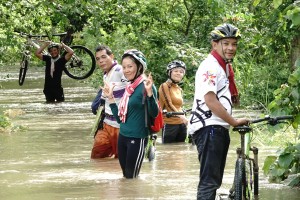 The ‘road’ from Ta Bos village to BeTreed that we’d driven the night before
The ‘road’ from Ta Bos village to BeTreed that we’d driven the night before
That was the easy part. The next flood had no excuse. There hadn’t even been a river the day before. But still we had to wade through, floating our bicycles across then return for the motorbike. Unsurprisingly the engine like everything else was flooded so we sent for Ben and his tool.
After a ‘cup o tea’ and a blissful bath in that empty period before dinner when we should have been supping a cold beer, I asked Ben to tell the story of Ta Bos Village and the Rosewood Tree.
Dense slow growing trees with a rosy tint to the wood and incredibly valuable, there was one big one left. They tried to cut it down with a handsaw but it was too dense so they came back with a chainsaw. Ben found it the next day and placed his rangers around the fallen trunk to catch the loggers when they came back to collect.
A tree so valuable was such big news a timber merchant got to hear of it and offered Ben $100,000 if he could get it legally signed off by the MoE. The provincial governor and minister agreed that Ben could sell the tree and use the money to help the local community.
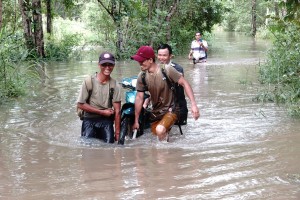 Carrying the motorbike across
Carrying the motorbike across
Back to the gods and demons, the commune chief wanted it for himself so he whipped up the local thugs who surrounded BeTreed and threatened to burn it down with or without Ben’s family inside. Ben called the governor who sent an army of military police with guns, which scared the thugs. They burnt the forest as they left.
Give it to them, said the governor. The commune chief and his thugs got the tree, sold it for a fraction of what it was worth and kept the money. It’s a daily battle that Ben wins while he can pay the police but he’s running out of money, what next?
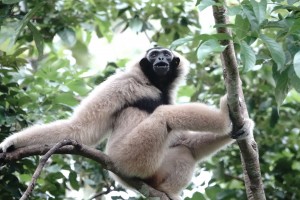 Molly the Pileated Gibbon
Molly the Pileated Gibbon
Too much! The table groaned under the weight of food, the team groaned with indigestion and Micky the three legged dog groaned with delight as copious left overs made their way onto the floor.
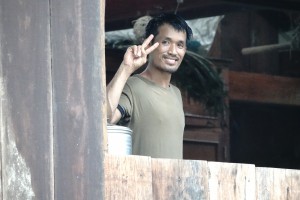 Manus the other gibbon
Manus the other gibbon
Palming a beer or two Manus and I left for the tree house, ten meters up amidst the forest canopy and now calm in the quiet evening after the crashing rain last night
The calm didn’t last as Manus woke me for the third time with a plaintiff plea for medicine. We traipsed down the hill past a poised pit viper to the lodge to get our first aid kit. Just give him Paracetamol said Ben when we woke him, which meant go away. Combined with Valium and Ibuprofen it was enough to make Manus pass out, snore all night and wake refreshed.
Breakfast was another enormous meal. Don’t eat too much. Can I cycle? No you were dying last night. Ben took those that didn’t want to ride and their bikes in his truck with the idea that he’d drop them off at the high tide’s edge. As fast as it had come up the water had receded so he drove through to the village.
I glowered at any young man who came into eyeshot and felt that no one gave a fuck about anyone else or anything. Like the emaciated dog that got caught under Ben’s truck and now lay in the middle of the road with its brains leaking out. Even Try who’d been my hero the last time I came now won’t work for Ben after he’s taken guests and got a tip.
I swallowed a big lump after Ben had dropped us off in Ta Bos village and said goodbye. The enormity of what he’s trying to achieve for people who don’t care struck home. Uncouth certainly but a hero who dedicates his life for what he believes in; conservation, biodiversity & beauty when the world seems set on greed, destruction and uniformity.
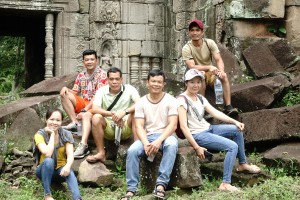 The Team at the East Entrance to Preah Khan including Mengly (2nd left)
The Team at the East Entrance to Preah Khan including Mengly (2nd left)
Preah Khan -Kampong Svai (that’s where it is). We got here yesterday but were too tired to take in the temple. JVII’s first, he built it while amassing an army to oust the revolting Cham from Angkor. (read https://indochineex.com/blog/angkor/story-jayavarman-vii-told-temples)
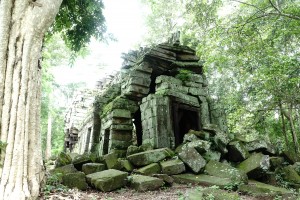 Inside Preah Khan
Inside Preah Khan
Ta Prohm with its twisted tree roots and Beng Melea with its meandering boardwalks, are described as the jungle temples of Angkor but its Preah Khan that really feels like the forgotten forest temple.
A few structures remain relatively intact and there’s been some restoration or shoring up, but most of the complex is littered with carved blocks adorned by butterflies that damp morning.
It seemed too soon that Manus was calling for me to leave as the rest of the team waited by the van.
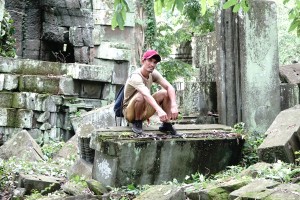 The other gibbon inside Preah Khan
The other gibbon inside Preah Khan
And that was the end of the adventure or so we thought but not quite as we still had fifty meters of flooded road to cross, South of Ta Siem, pulled by a kroyun for 15,000R (~$4).
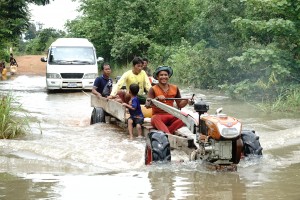 Just when we thought it was all over – heading South to Stoung
Just when we thought it was all over – heading South to Stoung
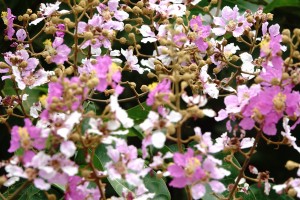 A flower to finish
A flower to finish
Indochine Exploration is pleased to partner with and support BeTreed www.betreed.com with mountain bike and hiking adventures. Please contact us at info@indochineex.com
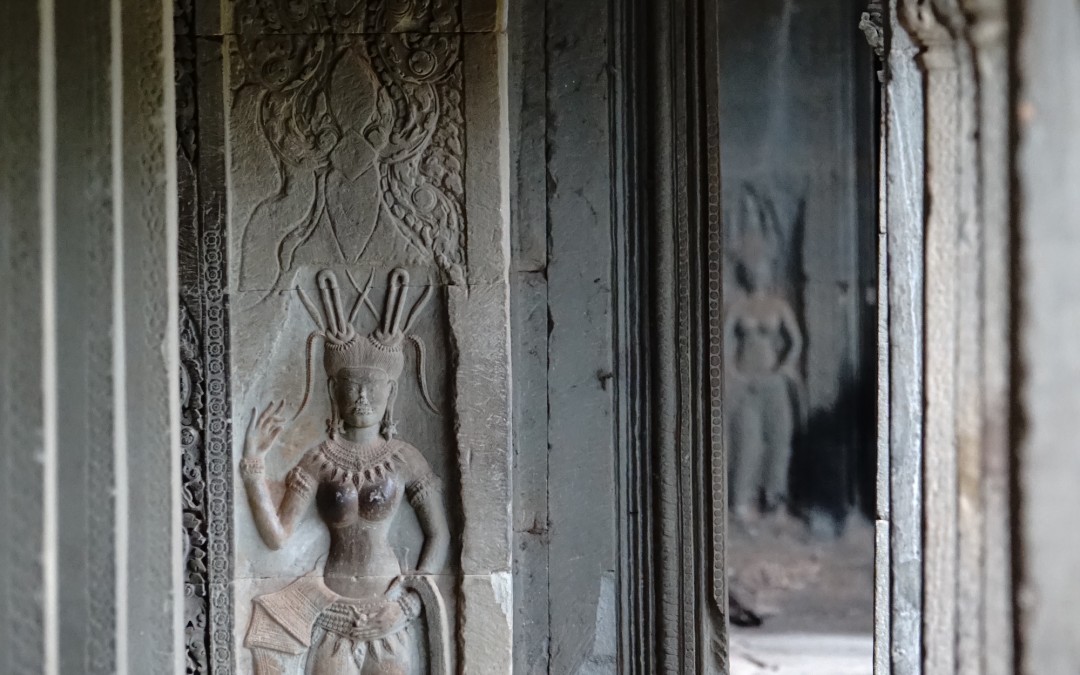
by Nick | Aug 16, 2019 | Angkor, Blog
The Churning of The Sea of Milk
The bas-reliefs on the walls of Angkor Wat are perhaps the pinnacle of Khmer Art. The carvings 2 meters high, stretch for a staggering 600 meters around the temple and depict scenes from the great Hindu stories, including the phantasmagorical if fundamental Churning of The Sea of Milk, which goes something like this;
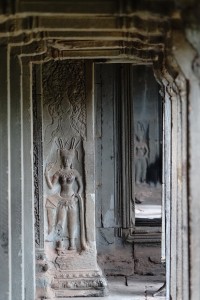 The outer corridor alongside the Churning of the Sea of Milk
The outer corridor alongside the Churning of the Sea of Milk
The Gods and Demons decided they had had enough fighting and it was looking like they were going to destroy the world so they went to Vishnu for advice.
Vishnu suggested they put all the medicine they could lay their hands on into the Sea of Milk to create the elixir of life that would bestow indestructibility amongst many other amazing things to whoever drank it, then have a big tug of war to see which lucky team got the joy juice.
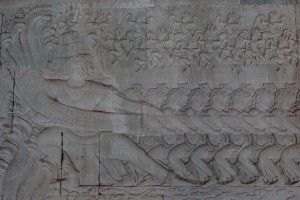 Ravana an Assura (demon) with the head of Vasuki (snake king)
Ravana an Assura (demon) with the head of Vasuki (snake king)
The recipe for Amrita as the elixir of life is known, goes something like this; take one ocean and churn thoroughly with a celestial blender until the ocean thickens, a thousand years is suggested. A good test of when you’re getting close is buxom Apsara or nymphs will start to evaporate from the seminal waters.
But what could they use for a blender. A rope that hundreds maybe thousands of hunky Demons and Gods could tug on and something to tug round was needed. The serpent that lived at the bottom of the ocean of course, actually he was Vasuki king of the snakes and Mount Mandara.
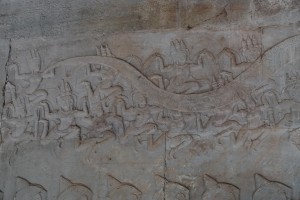 Buxom nymphs or Apsara arising out of the seminal fluid in anticipation of amrita
Buxom nymphs or Apsara arising out of the seminal fluid in anticipation of amrita
The Demons got the head* and the Gods the tail and they tugged for a thousand celestial years (which is a very long time), round the mountain in the middle of the ocean.
*Read on to find out why Vishnu tricky as ever and it has to be said a little biased in favor of the Gods had advised them to take the tail end and leave the head to the demons.
They tugged so hard that the mountain sank. Vishnu in his second reincarnation (there were ten in total) came to the rescue as a convenient and rather large tortoise lifting up the mountain on his back.
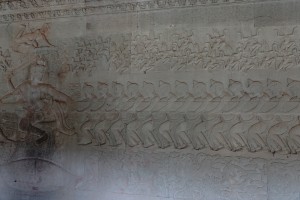 Vishnu sitting on his avatar (reincarnation) the Turtle encouraging the tugging Divas (Gods)
Vishnu sitting on his avatar (reincarnation) the Turtle encouraging the tugging Divas (Gods)
Meanwhile Vasuki, the king of snakes was getting pretty fed up of being tugged by hunky Gods and Demons for a thousand celestial years. Exhausted he sprayed the Demons (since they’d got the head) with halahala that was definitely not going to bring joy to the juice, there was also the small matter of destroying creation.
Shiva to the rescue, he sucked up the halahala thus saving creation and the rather wingy Gods but in the process got a sore throat and turned blue. His wife Parvati was so alarmed that she used Shiva’s chariot to dig a lake, which cooled his throat.
Anyway that’s about the end of the story. It seems in the end everyone was happy and there was enough joy juice to go round. The Gods got lots of divine nymphs while the demons got the grumpy goddess Varuni, who had a bit too much halahala. Vishnu got a new wife Lakshmi and Shiva, now recovered got a moon to wear on his head.
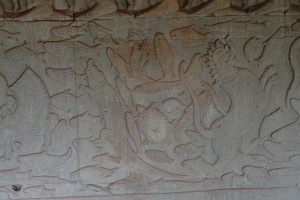 All the creatures of the ocean getting churned in the Sea of Milk
All the creatures of the ocean getting churned in the Sea of Milk
Another ending to these celestial shenanigans was that as the thousand years stated in the recipe were up and the ocean turned into the elixir of life. There was much singing and dancing. Apsaras flew up from the waters and white elephants trumpeting the occasion also had a go at flying.
The Gods, Demons and cosmic blender, Vasuki had done their job turning the ocean into joy juice now born in an urn by a heavenly physician. Quick as flash the demons grabbed the urn from the Doctor’s arms and were about to drink when the most beautiful girl in the world appeared.
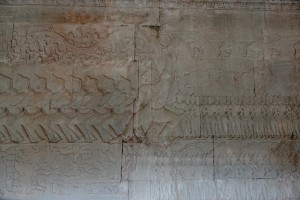 Hanuman, the monkey god making sure the Divas keep tugging
Hanuman, the monkey god making sure the Divas keep tugging
Will you give me anything I want? She pouted her lips and thrust out her bosom, anything, anything, they cried. Will you give me your joy juice? We will we will, they sighed exhausted. Snatching the moment the beautiful girl, actually Vishnu, gathered up the elixir of life and scarpered over to the Gods, who rubbed whatever Gods rub in anticipation of their impending transformation. They were already Gods so I’m not sure what they were getting transformed into but they were very happy.
This ‘story’ doesn’t end there because the Demon Rahu, who knew what a tricky character Vishnu was, that is if you were a demon. Had managed to get a quick slurp of the amrita but not before he’d been spotted by the sun and moon who told Vishnu what he was doing. Vishnu now back in his chiseled form cast his discus to cut off Rahu’s head. Rahu had managed to get in a quick sip but hadn’t swallowed yet so while his head was impervious to the oiled God’s manly manipulation of his orb, Rahu’s body died.
Not one to forget a grudge Rahu or his head had it in for the Sun and Moon and plunged the world into darkness but his bark was worse than his bite so the Sun and Moon laughed at him and moved out of eclipse.
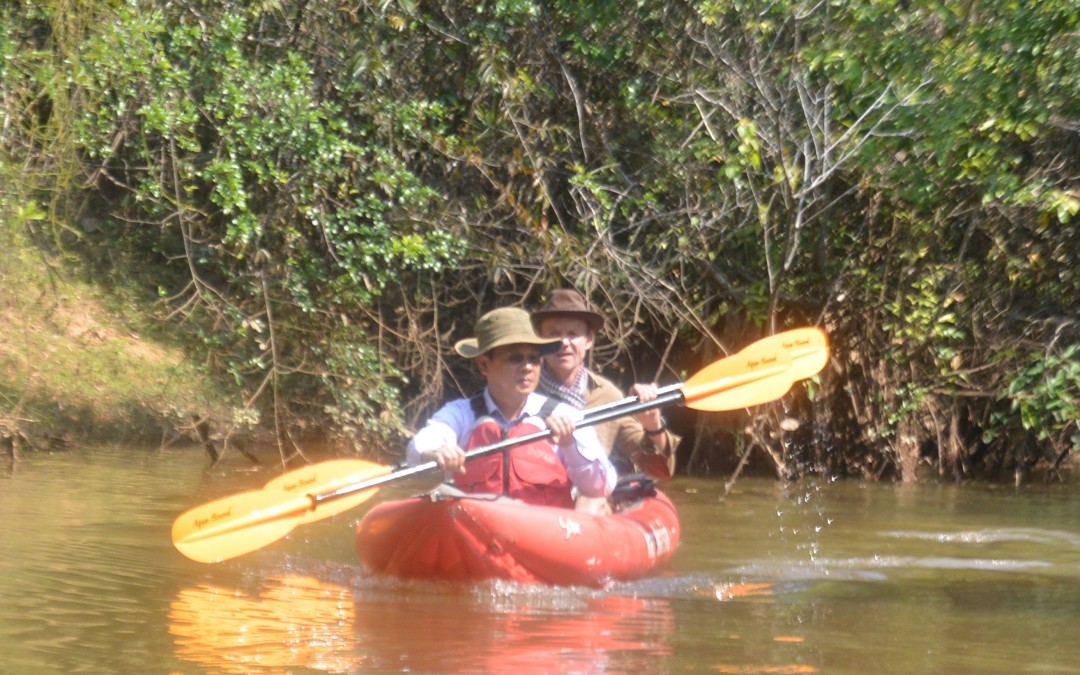
by Nick | Aug 6, 2019 | Angkor, Blog, Kayak
Background
The rise and fall of the Angkorian Empire, which lasted nearly 600 years from the 9thto the 14th century, was centered in what is now Siem Reap Province, around its greatest religious monument Angkor Wat. The metropolis of Angkor comprising nearly a million people covered a thousand square kilometers servicing what remained the largest city in the world until London eclipsed it seven hundred years later.
 Angkor Thom Moat, one of the great waterways that maintained ground water below the temple and prevented subsidence
Angkor Thom Moat, one of the great waterways that maintained ground water below the temple and prevented subsidence
Key to the success of the civilization was the management of water in a region of inundation and drought. An elaborate system of canals and barays or reservoirs channeled water from the Kulen Hills to the North into the city bringing food security in the form of rice and flood mitigation during the monsoon.
The availability of water ensured that food went in and shit went out. Canals facilitated the construction of the temples conveying the stone from the quarries to the North. And the temples were built with defensive moats that maintained ground water levels preventing subsidence (as well as looking pretty).
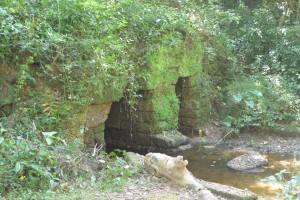 Runta Dev, the tunnel under the 8m high walls of Angkor Thom that channeled waste-water out of the city into the moat
Runta Dev, the tunnel under the 8m high walls of Angkor Thom that channeled waste-water out of the city into the moat
Just as water was the key to the empire’s success it is now thought to be instrumental in its decline. Not long after the death of the great king JVII in 1218 the kingdom was hit with a double whammy. First 30 years of drought followed by exceptional floods, which washed away the elaborate and sophisticated water management system that JVII in particular had built.
In recent years the importance of these systems has been recognized again as the massive increase in tourism has lead to ground water levels falling and the potential collapse of the temples. It is no coincidence that the best preserved are those with functioning moats.
One man has been championing the restoration of the Angkorian water management. His excellency Hang Peou now Director General of Apsara, the authority responsible for managing the UNESCO world heritage site, has overseen the construction of canals that channel the Siem Reap River into the North Baray, the moats of Preah Khan, Ankgor Thom and even Angkor Wat. Reducing the possibility of Siem Reap flooding as it did in 2011. And maintaining the ground water levels that prevent subsidence of the temples.
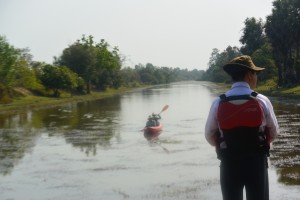 Peou overseeing our progress up the North Baray Channel
Peou overseeing our progress up the North Baray Channel
These small matters aside obviously the most important function of Angkorian hydrology is to allow us to paddle through the Angkor Park, Cambodia’s best preserved 400 km2 of lowland mixed evergreen and deciduous forest.
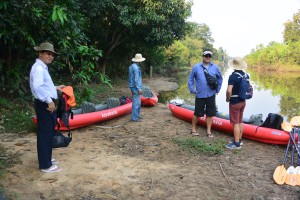 Peou and Jady with Buntha contemplating our adventure
Peou and Jady with Buntha contemplating our adventure
And so it was one Monday morning that Peou, then Director of Water Management at Apsara, facilitated by Jady, a consultant working with Apsara together with Buntha and myself kayaked through the heart of the Angkor Park. Jady and I had previously recce’d Peou’s canal so this time we didn’t get lost and anyway Peou knew the way, but – we hadn’t followed the river as it heads South to the city.
The current had cut deep into the soft ground leaving 7meter high banks that we had to scramble down with our kayaks and then awkwardly get in them*.
*Evidence of the destruction of JVII’s waterworks as floods washed away his canals and gouged deep scars through Angkor.
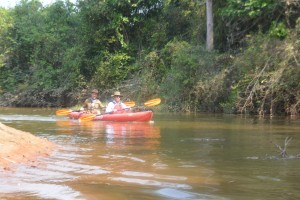 Paddling down the Siem Reap River
Paddling down the Siem Reap River
A few fallen branches had accumulated enough flotsam and jetsam to block the river with no way through but a messy scramble. Jady and Buntha paved the way. Poeu and I made it easy.
There are 700 Angkorian structures inside the Angkor Park but only 180 of them can be called temples, they’re the ones with moats. These monumental stone edifices need solid ground for their structural integrity, without it they crumble to a pile of stones. Siem Reap is a built on a light sandy soil, water gives it substance, which is what the moats do for the temples.
A few hundred meters on either side there were no doubt bus loads of Asian tourists but here in the heart of Angkor we paddled passed explosions of bamboo erupting on either side. White-collared Kingfishers taunted Buntha to catch a photo. A Snake Eagle followed our progress from above, while a Shikra watched us with disinterest from a fallen branch. All manner of other birds sang from the trees on either side obliterating any thoughts of tourists or even other people.
We’d catered for 5 pax kayaking but one of the water management guys came along for the ride so the third kayak was one paddle power short and we had visions of Kosal, Jady’s assistant unable to move his shoulders for a month or 2. They’d had the sense to share the work and caught up beaming and claiming the big adventure.
Our driver had accumulated helpers by the time we reached the sluice gates at the French Bridge (confusingly built by Americans), who pulled us up the steep stairs to Peou and Jady’s vehicles.
It took a while to sink in that we had paddled through one of the wonders of the world, visited by 3 million people but seen none, instead thick riparian forest as if we were discovering it for the first time.

 Loading Mr Chou’s oxcart
Loading Mr Chou’s oxcart Our lunch spot
Our lunch spot The guests arriving
The guests arriving Relaxing* on the trail
Relaxing* on the trail  Arriving at the campsite
Arriving at the campsite  Lors and ….
Lors and …. other flowers of the veld
other flowers of the veld Lors and Phum preparing supper
Lors and Phum preparing supper

 with Phum on the trail (left)
with Phum on the trail (left) The North Facing Kulen Escarpment
The North Facing Kulen Escarpment

 The central tower of Chan Ta Oun
The central tower of Chan Ta Oun A divine figure from Buddhist mythology
A divine figure from Buddhist mythology looking into the inner enclosure of Banteay Thom
looking into the inner enclosure of Banteay Thom The central towers of Banteay Thom
The central towers of Banteay Thom Phum Char (or Char Village)
Phum Char (or Char Village) Prasat Char
Prasat Char
 Prasat Kok Po
Prasat Kok Po Spean Memay
Spean Memay  The West Baray
The West Baray

 Manus leading the group on the forest path to Preah Khan
Manus leading the group on the forest path to Preah Khan A forest flower
A forest flower Veasna and Buntha
Veasna and Buntha Sreymom, Manus and Try our guide
Sreymom, Manus and Try our guide Left to right; Buntha, Veasna, Pov, Try, Nick, Manus and Sreymom
Left to right; Buntha, Veasna, Pov, Try, Nick, Manus and Sreymom Prasat Preah Steung, part of the Preah Khan complex of temples
Prasat Preah Steung, part of the Preah Khan complex of temples Manus soaked in sweat after the ride
Manus soaked in sweat after the ride Ta Siem Village where we had lunch
Ta Siem Village where we had lunch The ‘road’ from Ta Bos village to BeTreed that we’d driven the night before
The ‘road’ from Ta Bos village to BeTreed that we’d driven the night before Carrying the motorbike across
Carrying the motorbike across Molly the Pileated Gibbon
Molly the Pileated Gibbon Manus the other gibbon
Manus the other gibbon The Team at the East Entrance to Preah Khan including Mengly (2nd left)
The Team at the East Entrance to Preah Khan including Mengly (2nd left) Inside Preah Khan
Inside Preah Khan The other gibbon inside Preah Khan
The other gibbon inside Preah Khan Just when we thought it was all over – heading South to Stoung
Just when we thought it was all over – heading South to Stoung A flower to finish
A flower to finish
 The outer corridor alongside the Churning of the Sea of Milk
The outer corridor alongside the Churning of the Sea of Milk Ravana an Assura (demon) with the head of Vasuki (snake king)
Ravana an Assura (demon) with the head of Vasuki (snake king) Buxom nymphs or Apsara arising out of the seminal fluid in anticipation of amrita
Buxom nymphs or Apsara arising out of the seminal fluid in anticipation of amrita  All the creatures of the ocean getting churned in the Sea of Milk
All the creatures of the ocean getting churned in the Sea of Milk Hanuman, the monkey god making sure the Divas keep tugging
Hanuman, the monkey god making sure the Divas keep tugging
 Angkor Thom Moat, one of the great waterways that maintained ground water below the temple and prevented subsidence
Angkor Thom Moat, one of the great waterways that maintained ground water below the temple and prevented subsidence Runta Dev, the tunnel under the 8m high walls of Angkor Thom that channeled waste-water out of the city into the moat
Runta Dev, the tunnel under the 8m high walls of Angkor Thom that channeled waste-water out of the city into the moat Peou overseeing our progress up the North Baray Channel
Peou overseeing our progress up the North Baray Channel Peou and Jady with Buntha contemplating our adventure
Peou and Jady with Buntha contemplating our adventure Paddling down the Siem Reap River
Paddling down the Siem Reap River